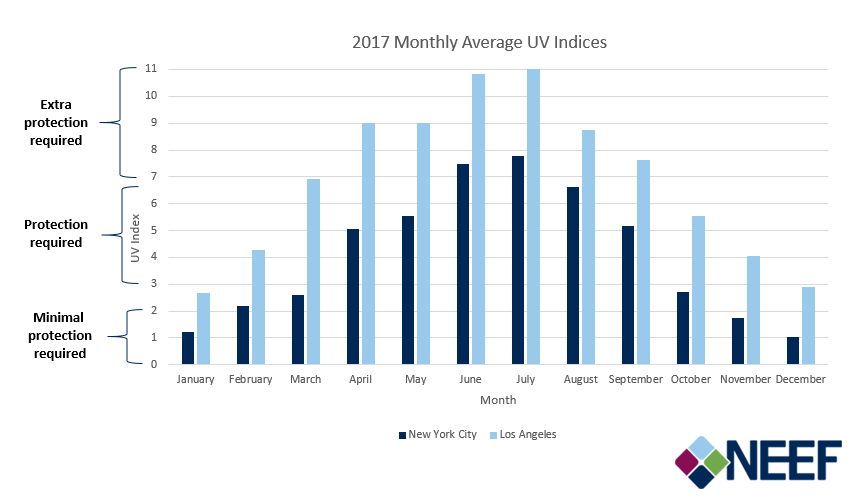
Summer may be over, but don't put away your sunscreen and sunglasses just yet! While summer is the time of year when you're typically exposed to the highest levels of skin-damaging ultraviolet (UV) radiation, there can be high levels of UV radiation reaching you year-round.
Regardless of what season you're in, the day's weather impacts your UV exposure. Ultraviolet radiation levels are highest under clear skies, and over 90% of incoming UV radiation can penetrate light cloud cover. Where you live also plays a major role in the amount of UV radiation you encounter: the tilt of the earth's axis and its route around the sun puts the equatorial regions in the path of almost year-round direct sunlight, making it the part of the world with the highest levels of UV radiation. The closer you move towards the poles, the lower the levels of UV radiation.
To give you an idea of how much your exposure to UV radiation can vary, the graph below shows the average monthly UV Index levels for New York and Los Angeles from 2017. The UV Index is the net level of UV radiation reaching an area, accounting for mitigating factors such as location, elevation, and cloud cover. The UV Index is used by the US Environmental Protection Agency and the National Weather Service to help people figure out how to prepare themselves for sun exposure every day—just like you prepare yourself for the daily weather! The low end of the index represents relatively low levels of risk of overexposure, and the risk increases as you move up the scale.

2017 Cloudy Sky UVI data obtained from NOAA National Centers for Environmental Prediction, National Climate Prediction Center
Check the UV index in your area
If you want to find the daily or hourly UV Index for your area, check out the SunWise UV Index online, or via the app. Based on the UV Index for the day, check the SunWise guide on how to prepare yourself for different levels of UV exposure to make sure you and your family have a safe time outside! To learn more about the SunWise program and access the lesson plans, resources, and activites, check out SunWise program homepage.
Sunscreen is recommended for all levels of UV exposure, but news about a common sunscreen ingredient causing damage to corals may have you worried about slathering up. Visit the National Park Service for information about “reef-friendly” products, such as those that contain titanium oxide or zinc oxide. Even if you aren't planning a dip in the ocean, the water from your shower is eventually released back into the waterways, where it can affect plant and animal life.
Sources:
- Earth Observatory. 2015. “Ultraviolet Radiation: How it Affects Life on Earth.” NASA. Accessed October 28. http://www.earthobservatory.nasa.gov/Features/UVB/uvb_radiation3.php
- National Park Service. 2015. "Protect Yourself, Protect the Reef!" US Department of the Interior. Accessed October 28. http://cdhc.noaa.gov/_docs/Site%20Bulletin_Sunscreen_final.pdf
- National Weather Service Climate Prediction Center. 2015. “UV Index: Annual Time Series.” NOAA. Accessed October 28, 2017. http://www.cpc.ncep.noaa.gov/products/stratosphere/uv_index/uv_annual.shtml
- National Weather Service Climate Prediction Center. 2015. “UV Index: Information.” NOAA. Accessed October 28. http://www.cpc.ncep.noaa.gov/products/stratosphere/uv_index/uv_what.shtml
- World Health Organization, World Meteorological Organization, United Nations Environment Programme, and International Commission of Non-Ionizing Radiation Protection. 2002. Global Solar UV Index: A Practical Guide. WHO/SDE/OEH/02.2. Geneva: World Health Organization. http://www.who.int/uv/publications/en/GlobalUVI.pdf?ua=1
- US EPA. 2015. “UV Index.” Accessed October 28. https://www.epa.gov/sunsafety/uv-index-1

